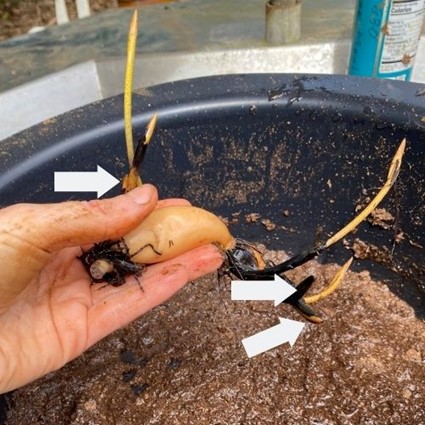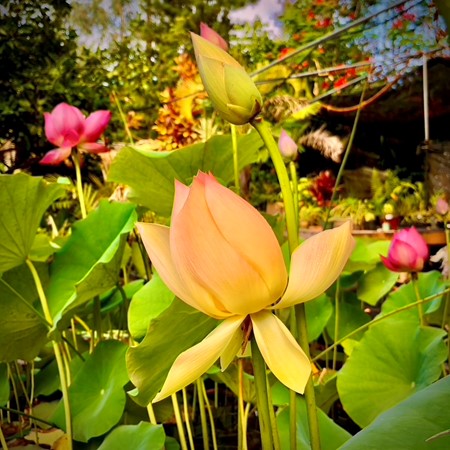The Mystical Lotus Plant
120 million years in the making, unscathed by the mud, and murky water it arises from, the sacred lotus (Nelumbo nucifera from Asia or Nelumbo lutea from North America) awakens to the light of spring. First, green, circular pads begin to pop up out of the mud, resting on the water’s surface. With the boost of photosynthesis, new leaves rise above the water, creating aerial pads that glisten with jeweled water droplets, that bead, pool, and spill off.
This ‘beading’ is owed to a special molecular structure that makes the plant ‘hydrophobic’, or repellant of water/mud/dirt. This is one of the most effective ways to differentiate between lotus and water lilies: water lily pads sit on the water’s surface, and do not bead water.
Assenting into summer’s peak, lotus buds will form, revealing themselves emerging up through the mud. After a few days, the hollow, prickly stem will soar gracefully, up to 6 feet high, and perched above the aerial leaves a blossom will begin to loosen its petals for a show-stopping open. The petals will elegantly fall open, one by one, revealing an intricate, yet amazingly simple flower, unparalleled in its potent beauty and mesmerizing, sweet aroma.
The colors can range from blended sunset hues (Golden Sunset), to candy pinks (Holy Fire and Spring Rain in Linan) and soft whites (Bali White), and even yellow (American Lutea, N. Lutea).
The lotus blooms for 3 to 4 days consecutively, opening in the morning and closing at night. Throughout the day, the plant absorbs and stores enough sunlight, to be able to radiate heat-energy in the blossom’s center – even as the air cools all around it at night. It is said that 40 lotus blossoms can emit enough energy to make a household lightbulb glow.
When the lotus closes at night, it sometimes traps its cold-blooded pollinator inside to fumble-bumble around, thoroughly dousing itself in the pollen. When the bloom opens in the morning, the pollinator’s body temperature is up and – most importantly – conducive to getting straight to work, making its way to the next open flower on its first day of bloom (female). The second- and third-day blossoms are male.
The Lotus is beautiful and intriguing, and it is also revered in many cultures as a sacred plant. Throughout the world, lotus is able to take root and grow, and it has found many uses in art, architecture, textiles, medicine, cuisine and religious or spiritual symbolism.
Your lotus may be calling for your assistance this time of year.
On Kaua’i, now is the time the lotuses are waking up from their winter slumber, making it the ideal time to repot. They remain dormant until February and begin waking up as the weather warms and the arc of the sun expands. This is a great time of year to start envisioning your peak summer garden. Including the majestic lotus will absolutely be a highlight.
There are hardy and tropical lotus varieties.
The Sacred China Lotus, like all hardies, should be repotted every year for optimal blooming. Our tropical lotus, the Taiwan Rose, only needs to be repotted every other year. If the lotus gets too root-bound it will not continue to grow and bloom.
Repotting includes:
-carefully removing and rinsing lotus rhizomes or roots
-using a sickle, cutting back root stock to only three growing tips, (being careful not to break any growing tips or stems),
-replanting it in a mix of peat, dirt, bone meal and strata in a low, 5 gallon plastic pot
-keep potted plant submerged in water, being careful not to let the roots dry out (a low ceramic pot is ideal for the potted lotus)
-watch your lotus grow new leaves, withhold fertilization until you have three aerial leaves.
–Once the plant is robustly growing you may fertilize it every three weeks-to a month to encourage growth, and increase the likelihood of getting a spectacular bloom season.
Note: be careful not to break green stems or leaves, as this will ‘drown’ that rhizome seqment.
At the nursery, we grow a variety of lotus types. Depending on your needs, lotus can range from small ones for your tabletop (our beloved micro lotus, ‘Spring Rain in Linan’) to large plants for the largest ponds or a medium to large ceramic pot.
Create your own sacred lotus container pond.
Enchanting lotus blooms, with all their mystical charms, can make an attractive addition to your yard. When well placed in low ceramic containers, the lotus will offer blooms all summer long. May the unfolding of your first lotus blossom bring you a thousand petals of delight!
Garden Ponds is located in Kilauea, next to the Kauai Mini Golf. We are open Wednesday through Sunday, noon to 5 p.m. Give us a call at 808-828-6400 or visit us at www.gardenpondskauai.com/blog-2/ to read our blog, which has more information on growing lotus, water lilies and other water garden ideas.
Photo Below:
Repot lotus root rhizomes with three growing tips, in a 5 gallon plastic pot with peat, bone meal, dirt and strata. Do not fertilize until you see three big leaves standing tall above the water and be careful not to break a growing tip or a stem (shown with arrows).

